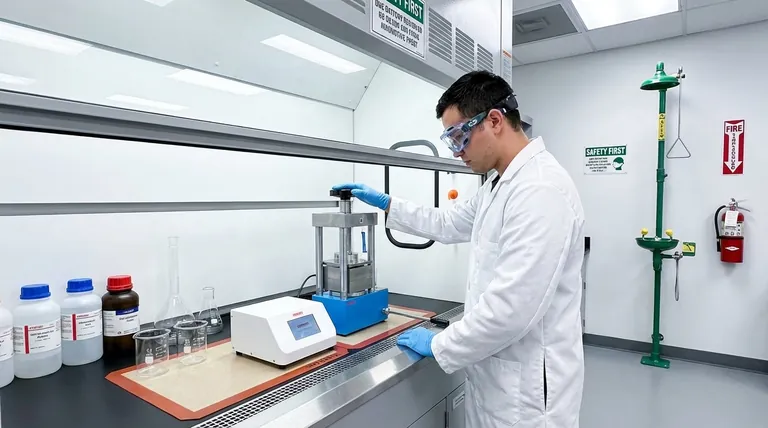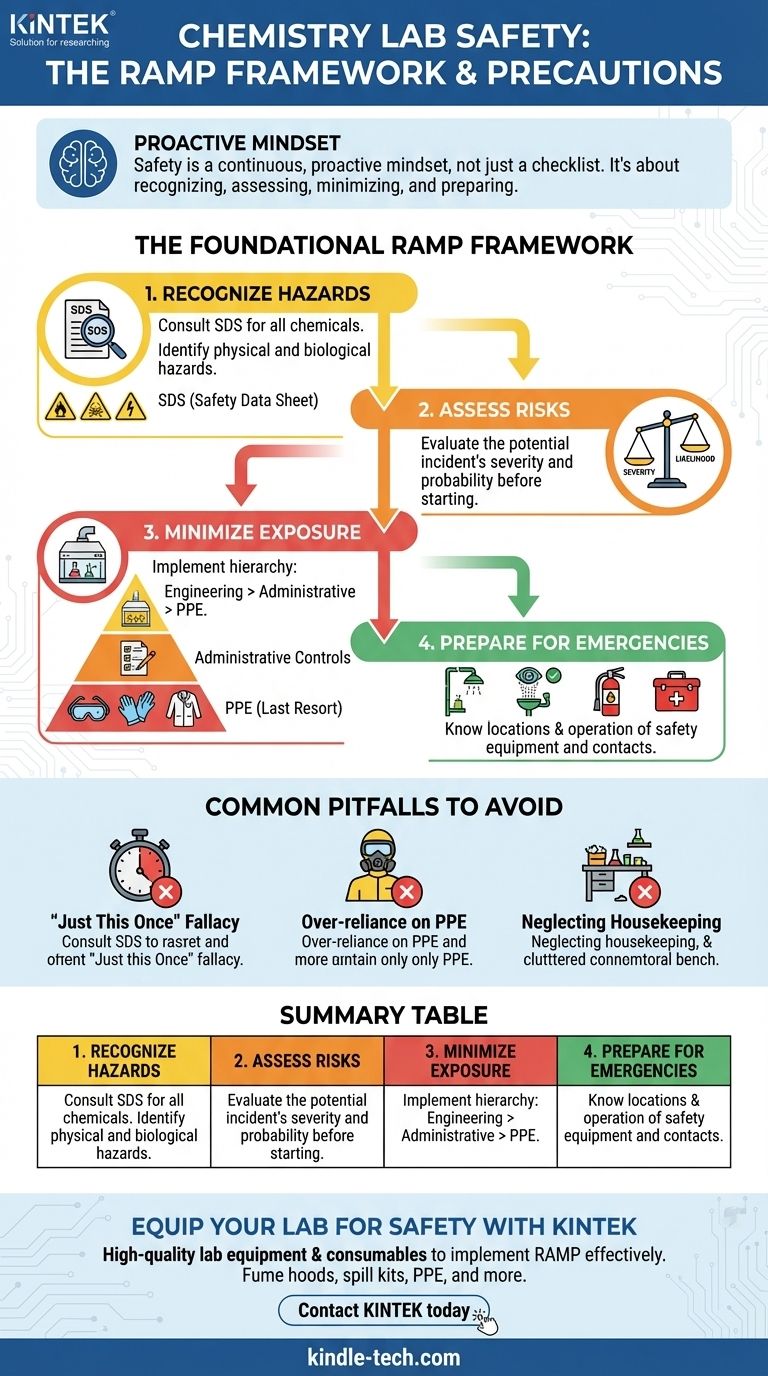화학 실험실에서 가장 중요한 예방 조치는 관련된 물질과 과정에 대한 기본적인 존중을 중심으로 이루어집니다. 최소한 여기에는 항상 적절한 개인 보호 장비(PPE)를 착용하고, 취급하기 전에 사용하는 모든 화학 물질의 특정 위험을 이해하며, 모든 비상 안전 장비의 정확한 위치와 작동 방식을 아는 것이 포함됩니다. 절대 혼자 작업하지 말고, 사고를 예방하기 위해 항상 깨끗하고 정돈된 작업 공간을 유지하세요.
진정한 실험실 안전은 암기해야 할 규칙 목록이 아니라 지속적이고 능동적인 사고방식입니다. 이는 실험을 시작하기 전에도 위험을 인식하고, 위험을 평가하며, 노출을 최소화하고, 비상 상황에 대비하는 프레임워크를 기반으로 합니다.

기본 프레임워크: RAMP
견고한 안전 문화는 실험실의 모든 작업에 접근하기 위한 간단하면서도 강력한 프레임워크인 RAMP 원칙을 기반으로 구축됩니다.
위험 인식
작업을 시작하기 전에 잠재적인 해로운 원인을 식별해야 합니다. 위험은 항상 명확하지 않습니다.
모든 화학 물질에는 이전에 MSDS로 알려졌던 안전 데이터 시트(SDS)가 있습니다. 이 문서는 가연성, 독성, 반응성 및 필요한 안전 조치에 대한 주요 정보원입니다.
화학 물질 외에도 고압 시스템, 극한 온도 및 전기 장비와 같은 물리적 위험을 고려하십시오. 해당되는 경우 생물학적 위험도 자체적인 특정 프로토콜이 필요합니다.
위험 평가
위험을 인식하는 것이 첫 번째 단계이며, 그 다음은 위험을 평가하는 것입니다. 위험은 잠재적 사고의 심각성과 발생 가능성의 조합입니다.
스스로에게 물어보세요: 최악의 시나리오는 무엇인가? 이 실험은 어떻게 실패할 수 있는가? 소량의 약한 자극제는 다량의 고부식성 또는 폭발성 물질과는 매우 다른 위험을 초래합니다.
이 평가는 절차에 필요한 통제 조치의 수준을 결정합니다.
위험 최소화
이것은 안전의 능동적인 부분입니다. 즉, 위험을 줄이기 위한 통제 조치를 구현하는 것입니다. 이는 명확한 계층 구조로 이루어집니다.
가장 효과적인 방법은 위험을 제거하는 물리적 설치물인 공학적 통제를 사용하는 것입니다. 가장 중요한 예시는 독성 또는 휘발성 증기를 사용자로부터 환기시키는 화학 흄 후드입니다.
다음은 따르는 절차 및 프로토콜인 행정적 통제입니다. 여기에는 모든 용기의 적절한 라벨링, 혼자 작업하지 않는 것, 실험에 대한 표준 작업 절차(SOP) 개발이 포함됩니다.
마지막 방어선은 개인 보호 장비(PPE)입니다. 여기에는 비말 방지 화학 고글, 방염 실험복, 적절한 내화학성 장갑, 덮인 발가락 신발이 포함됩니다. PPE는 사고를 예방하지는 않지만, 사고 발생 시 부상으로부터 보호할 수 있습니다.
비상 상황 대비
최고의 계획에도 불구하고 사고는 발생할 수 있습니다. 대비는 필수적입니다.
안전 샤워기, 눈 세척대, 소화기, 유출 키트의 정확한 위치와 올바른 사용법을 알아야 합니다. 비상 상황에서는 몇 초가 중요하며, 지시를 찾을 시간이 없습니다.
비상 연락처가 명확하게 게시되어 있는지 확인하고, 아무리 사소해 보이더라도 사고 보고에 대한 실험실의 특정 절차를 이해해야 합니다.
일반적인 함정과 오해
안전 프로토콜 준수는 안일함과 실제 위험이 어디에 있는지에 대한 오해로 인해 훼손될 수 있습니다. 이러한 일반적인 함정을 피하는 것은 규칙을 따르는 것만큼 중요합니다.
"이번 한 번만" 오류
대부분의 실험실 사고는 이국적이고 고위험 절차로 인해 발생하는 것이 아닙니다. 이는 일상적인 작업에서 사소한 일탈로 인해 발생합니다. 예를 들어, "빠른" 이동을 위해 고글을 건너뛰거나 "소량"의 화학 물질에 대해 흄 후드를 사용하지 않는 경우입니다.
이러한 일탈의 정상화는 안전한 실험실 문화에 대한 가장 큰 위협입니다. 기본적인 안전 조치를 건너뛸 만큼 "빠른" 작업은 없습니다.
PPE에 대한 과도한 의존
많은 사람들이 PPE를 안전의 주요 도구로 생각합니다. 이는 잘못된 생각입니다. PPE는 모든 다른 통제 조치가 실패했을 때 보호하기 위한 마지막 방어선입니다.
튀는 것을 막기 위해 장갑에 의존하는 것은 튀는 것을 애초에 방지하는 절차를 구현하는 것보다 훨씬 덜 효과적입니다. 항상 PPE보다 공학적 및 행정적 통제를 우선시하십시오.
정리 정돈 소홀
어수선한 작업대, 라벨이 없는 용기, 막힌 비상구는 불필요하고 완전히 피할 수 있는 위험을 만듭니다. 깨끗하고 정돈된 실험실은 전문적이고 안전 의식이 있는 사고방식을 직접적으로 반영합니다.
정리 정돈은 단지 깔끔함을 위한 것이 아닙니다. 이는 유출, 교차 오염, 넘어지거나 미끄러지는 사고의 가능성을 줄이는 중요한 행정적 통제입니다.
귀하의 역할에 적용
안전에 대한 접근 방식은 실험실 환경 내에서의 책임에 따라 달라집니다.
- 실험실 관리자 또는 책임 연구원인 경우: 주요 초점은 강력한 공학적 통제를 확립하고 안전 프로토콜이 일관되고 보편적으로 준수되는 문화를 조성하는 것입니다.
- 연구원 또는 학생인 경우: 주요 초점은 개인적인 책임입니다. 수행하는 모든 작업에 대해 RAMP 원칙을 철저히 이해하고, 준비되지 않았거나 불확실하다고 느끼면 절대 진행하지 않는 것입니다.
- 새로운 실험실을 설계하거나 설치하는 경우: 주요 초점은 올바른 환기, 논리적인 작업 흐름, 쉽게 접근할 수 있는 비상 장비를 통해 처음부터 물리적 환경에 안전을 구축하는 것입니다.
궁극적으로 훌륭한 과학과 훌륭한 안전은 분리할 수 없습니다.
요약표:
| 예방 조치 범주 | 주요 조치 |
|---|---|
| 위험 인식 | 모든 화학 물질에 대한 안전 데이터 시트(SDS)를 참조합니다. 물리적 및 생물학적 위험을 식별합니다. |
| 위험 평가 | 작업 시작 전에 잠재적 사고의 심각성과 가능성을 평가합니다. |
| 위험 최소화 | 공학적 통제(예: 흄 후드), 행정적 통제를 사용하고 적절한 PPE를 착용합니다. |
| 비상 상황 대비 | 안전 샤워기, 눈 세척대, 소화기, 유출 키트의 위치와 작동 방식을 숙지합니다. |
| 일반적인 함정 피하기 | "빠른" 작업을 위해 안전 조치를 건너뛰지 마십시오. PPE보다 통제를 우선시하십시오. 깨끗한 작업 공간을 유지하십시오. |
KINTEK과 함께 안전하고 성공적인 실험실을 구축하세요
안전한 실험실 환경을 조성하는 것은 신뢰할 수 있는 연구와 발견의 기초입니다. KINTEK은 귀하의 작업이 안전하고 잘 갖춰진 공간에 달려 있음을 이해합니다. 우리는 RAMP 프레임워크를 효과적으로 구현하는 데 필요한 고품질 실험실 장비 및 소모품을 제공하는 데 특화되어 있습니다.
새로운 시설을 설립하는 실험실 관리자이든 신뢰할 수 있는 안전 장비가 필요한 연구원이든, KINTEK은 귀하의 신뢰할 수 있는 파트너입니다. 화학 흄 후드 및 유출 키트부터 개인 보호 장비(PPE)에 이르기까지, 우리는 위험을 최소화하고 팀을 보호하는 데 도움이 되는 도구를 공급합니다.
실험실에서 더 강력한 안전 문화를 구축할 준비가 되셨습니까? 저희 전문가들이 귀하의 특정 요구 사항에 맞는 장비를 선택하도록 도와드리겠습니다.
오늘 KINTEK에 연락하여 실험실 안전 요구 사항에 대해 논의하십시오!
시각적 가이드



